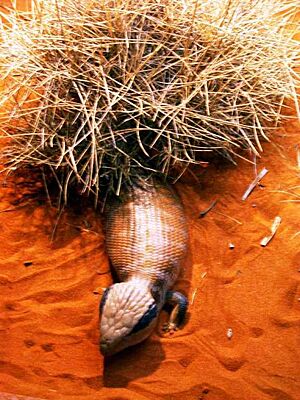Centralian blue-tongued skink facts for kids
Quick facts for kids Centralian blue-tongued skink |
|
|---|---|
 |
|
| Conservation status | |
| Scientific classification | |
| Genus: |
Tiliqua
|
| Species: |
multifasciata
|
The Centralian blue-tongued skink is a fascinating lizard found mostly in Australia. It's also known as the Centralian blue-tongue. Its scientific name is Tiliqua multifasciata. This skink is part of a group called Tiliqua, which includes other blue-tongued skinks and the shinglebacks. These lizards are known for their bright blue tongues!
Contents
What Does It Look Like?
The Centralian blue-tongued skink is a very strong and sturdy lizard. It has a short body and a thin tail. This skink is one of the largest lizards in its family, Scincidae. Both its front and back legs have five toes.
Its Cool Colours
This skink is mostly light brown or grey. It has about nine or more orange-brown stripes along its body and tail. These darker stripes are wider than the lighter grey-brown spaces between them. The stripes are narrowest along the middle of the skink's back.
A special black stripe goes around its eye and reaches just above its ear. The upper back parts of its legs are also black. The skink's belly is a pale cream or white colour.
Where Do They Live?
You can find the Centralian blue-tongued skink in many parts of Australia. They live in the far north-west of New South Wales and South Australia. They are also found in central Western Australia, the Northern Territory, and Queensland.
These skinks usually live in dry and semi-dry areas. They like places with stony ground and red sand. They often hide among spinifex plants, which are tough, spiky grasses.
How Do They Behave?
Like many other reptiles, the Centralian blue-tongued skink mostly stays on the ground. It is a ground-dwelling creature. It is also diurnal, which means it is active during the day.
These skinks don't travel very far. They usually move less than 20 metres at a time. On average, they might travel between 122 and 245 metres each day. They are quite relaxed and don't rush around much.
What Do They Eat?
Scientists have studied what the blue-tongued skink eats by looking at their stomach contents. They found that these skinks eat a mix of different things. Their diet includes seeds and insects.
They also eat animal waste, like livestock dung. Sometimes, they even eat small bits of other animals. This can include bone fragments or loose feathers from birds or other reptiles.
Baby Skinks
The Centralian blue-tongued skink is a viviparous species. This means that the mother gives birth to live young, instead of laying eggs. This is similar to how mammals have babies. A mother skink can have between two and 10 baby skinks in one litter.
What Are Their Dangers?
One big danger for the Centralian blue-tongued skink is the cane toad. These toads are not native to Australia and are poisonous. If a skink eats a cane toad, it can get very sick or even die.
Other dangers come from human activities. Things like wildfires and changes to their living areas can also affect them. Even with these threats, the Centralian blue-tongued skink is currently listed as a species of least concern. This means they are not in immediate danger of disappearing.



